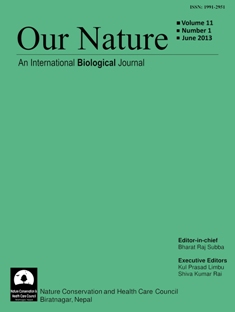Food and Feeding Habits of the Mola Carplet Amblypharyngodon mola (Hamilton, 1822) in Rice Field Ecosystem with Consideration of Water Quality Parameters
DOI:
https://doi.org/10.3126/on.v11i1.8245Keywords:
Amblypharyngodon mola, Food and feeding habits, Gut contents, Rice-field ecosystem, BangladeshAbstract
The present investigation was conducted in the Agronomy field laboratory of Bangladesh Agricultural University, Mymensingh, Bangladesh during May 1999 to August 1999 to reveal the food and feeding habits of Amblypharyngodon mola in the rice field ecosystem. Percentage of frequency of occurrence and percentage in number methods were used for the qualitative and quantitative estimation of plankton population. Results showed that, during the present study, the water quality parameters were within the suitable range for optimal fish growth and plankton population was abundant in the water of the rice plots. Gut content analysis of A. mola revealed a sum of 32 genera of phytoplankton belonging to Chlorophyceae (17), Euglenophyceae (2), Cyanophyceae (7) and Bacillariophyceae (6) and 8 genera of zooplankton under Rotifera (3), Cladocera (2) and Copepoda (3). In general, Navicula, Fragilaria, Chlorella, Chrysococcus, Closterium, Oscillatoria and Gomphosphaeria were found abundant both in the water of the rice plots and in the gut contents of A. mola indicating that, these genera are preferred food of this fish in the rice field ecosystem. Gut content analysis also exposed that, phytoplankton was the major food item constituting 94.38% of the gut contents’ composition of A. mola whereas zooplankton comprised only 5.62%. The results of this study conclude that, the A. mola is planktivorous in nature, feeding mostly on phytoplankton and could be a suitable species for integrated rice-fish farming.
DOI: http://dx.doi.org/10.3126/on.v11i1.8245
Our Nature Vol.11(1) 2013: 61-75
Downloads
Downloads
Published
How to Cite
Issue
Section
License
This license enables reusers to distribute, remix, adapt, and build upon the material in any medium or format for noncommercial purposes only, and only so long as attribution is given to the creator.




